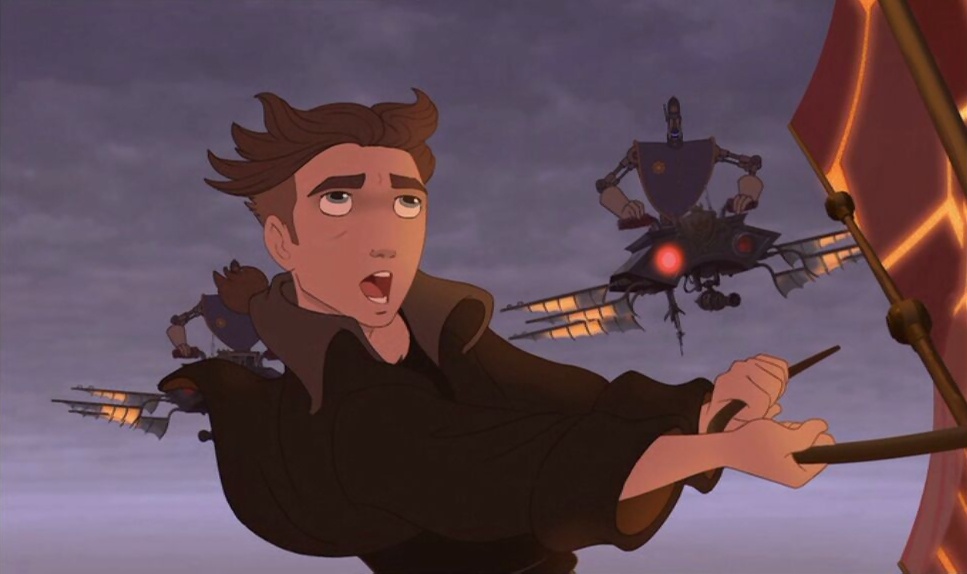Written by Ron Clements, John Musker and Rob Edwards
Directed by Ron Clements and John Musker
USA, 2002
Treasure Planet should have been one of Disney’s heavy hitters. The modern-day twist on Robert Louis Stevenson’s Treasure Island had a lot going for it. Pirate adventure in space filled with interstellar ships and mutinies? Check. Stunning visuals that combine traditional 2D and modern 3D animation? Check. A great cast of characters? Well, that depends on who you ask. Treasure Planet clearly wanted to teach its audience that there is greater value in self-discovery than a ship filled with treasure from a thousand worlds. However, when it came time to test the cut of its sails, Treasure Planet left audiences standing on the docks dreaming of what could have been, if only Jim had found a way to save the treasure.
Mind you, this Disney adventure did not fail because those watching are greedy. There are certain expectations placed on pirate adventures, especially when the word “treasure” is in the title, and in this case, audiences felt cheated. Let’s do a quick recap of Treasure Island to see where Treasure Planet went wrong.
In the novel, the trouble begins when a drunkard named Billy Bones takes up residence at the Benbow Inn owned by young Jim Hawkins and his mother. Day after day, Bones rattles on about a map that leads to Captain Flint’s haul, the treasure of treasures, and warns of a treacherous one-legged man. When Bones drops dead after receiving the black spot from a former crewmember, Jim and his mother discover a mysterious oilskin packet, as well as a gang of angry pirates. After finding refuge with Dr. Livesey and Squire Trelawney, it is determined that the only rational thing to do is acquire a ship, hire a crew, and find the treasure. One day while hiding in an apple barrel aboard the Hispaniola, Jim overhears the cook, a one-legged man named Long John Silver, plotting to mutiny. It is at this point that Jim makes a series of rash decisions that, while frustrating to his companions, ultimately forces the pirates to surrender; leaving all those involved with a hefty treasure as a reward for all their trials and tribulations. Treasure Planet sticks close to the source material, making minor changes that effect the movie in a big way.
This time around, Jim Hawkins is portrayed as clever and capable, just like his 19th-century counterpart, with the added bonus of being a troubled teen who is dangerously close to spending the rest of his youth behind bars. The source of Jim’s rebellious streak steams from his father’s abandonment when he was 5 years old, causing Jim to isolate himself from everyone. Thus, Billy Bones’ planetary map isn’t just a chance for Jim and his mother to lead a better life, it’s Jim’s last chance to change his fate.
Under the mentorship of astronomer Dr. Delbert Doppler, and the tutelage of the one-legged cyborg cook, Long John Silver, Jim indeed becomes a young man confident in his own skin. Jim learns the value of hard work, resists the temptation of gold (by blowing it up!), and puts the lives of others before his own. Upon returning home from his trek across the universe, Silver hands Jim just enough treasure to rebuild the Benbow Inn, allowing Jim to reconnect with his mother. Having proved his worth as a good and honest man, Jim becomes military as a cadet, putting the past behind him and stepping forward into a bright future.
At its core, Treasure Planet isn’t about becoming fabulously wealthy, it’s about finding out what you’re made of. It’s about learning what type of person you are when faced with extraordinary circumstances. Jim has spent so much time focusing his anger on his father’s desertion that he has completely forgotten to live.
There is one tiny detail that is difficult to move past: this movie is called Treasure Planet. Audiences anticipate some gold to make it on the return trip. After all, that’s what happened in Treasure Island. Jim outwits the pirates and Captain Flint’s treasure is split among those who were loyal to our brave hero. Heck, even old Long John gets a cut. Yet in Treasure Planet, the treasure, with the exception of a small handful Silver managed to grab, is destroyed.
Even before we watch Flint’s loot vanish in a fiery explosion, Jim’s strict righteous morals create a huge disconnect between himself and those observing the action. He doesn’t so much as bat an eye at Silver’s offer to turn pirate. How many of us would do the same? Think about that for a second.
Treasure Planet leans heavily on a coming-of-age story, leaving those who watched the filmed unsatisfied. If this movie had been called something else, perhaps things would have turned out differently. Alas, Treasure Planet lured audiences with the promise of treasure, but merely supplied a pat on the back.
— Elizabeth Rico




